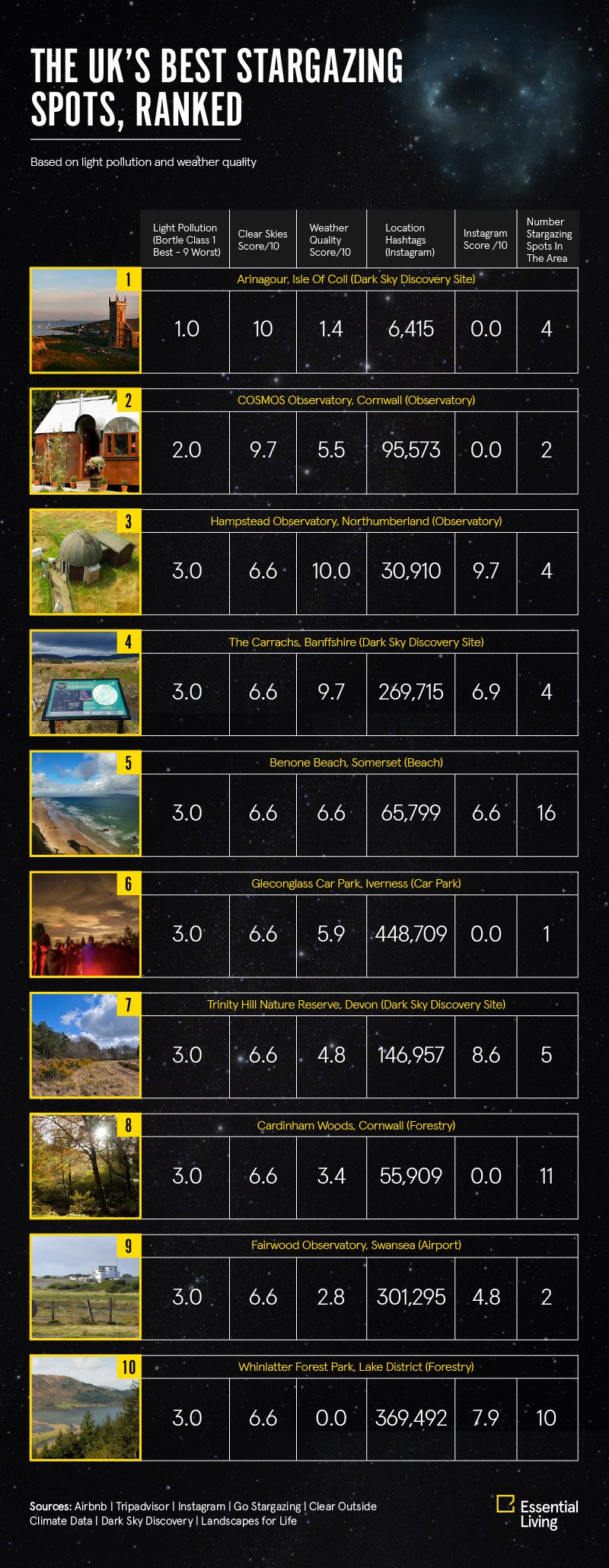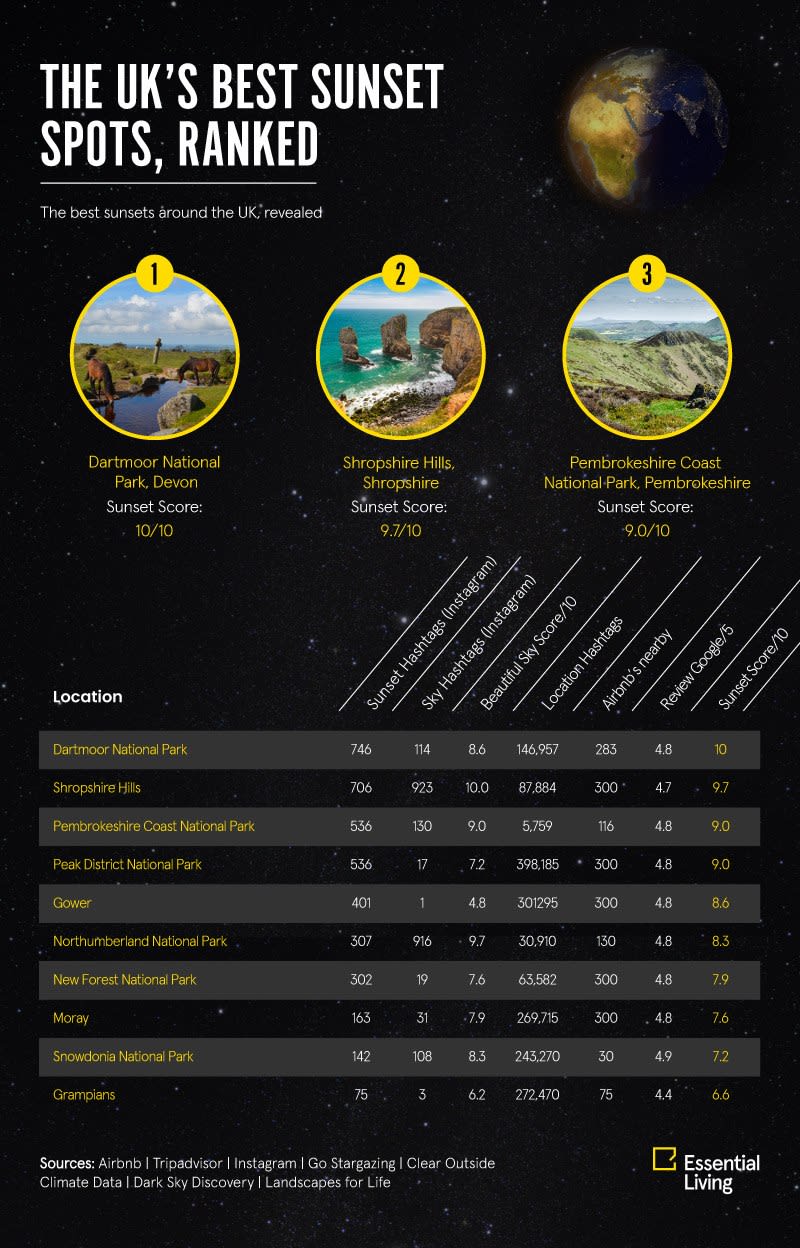Stargazing is a sure-fire way to feel closer to nature, as well as the people you choose to share the experience with. The peaceful and low-cost nature of this activity means that it is also a great way to help relieve the stress of city life and find your inner peace.
If you are going to take some time out in the countryside, then it should go without saying that you want the experience to feel perfect. So with this in mind, our research team has scoured the country in search of the best dark sky spots for that perfect stargazing trip.
Our scoping of the best dark sky spots around the UK is based on a number of factors including the highest hills to help you get closer to the stars, plus the volume of light pollution and rainfall in each area to assure your stargazing experience is not ruined by bad weather.
We have also taken into account how easy it is to access each stargazing spot by looking at the number of Airbnb listings in the area and the accessibility by train.
On top of all of that, we have seen how well each spot scores on social media by comparing Instagram hashtags with Google reviews — all to determine the most perfect stargazing trip in the UK.
The Best Stargazing Trips in the UK, Revealed
Our data reveals that the UK’s best dark sky spot is officially Dartmoor National Park, with a total score of 72.3 out of 100. The spot is one of the most accessible in the UK, with 283 Airbnb listings in the area, plus the nearest train station is only 4.5 miles away. The location has also been hashtagged 146,957 times on Instagram, and there’s little chance of rain in the area with just an average of 92.8cm of rain per year.
Following closely in second place is the Lake District National Park with an overall score of 70.1 out of 100. The Cumbria-based dark sky spot is blessed with some of the clearest skies in the country, with a Bortle Class light pollution score of three out of nine. There are also a high number of stargazing spots in the area, 10 to be exact. And if that’s not enough, the area is also home to England’s highest hill, Scafell Pike, which stands at 978m tall.
Third place goes to Moray, with this Scottish located dark sky spot scoring a total of 68.8 out of 100. Moray’s most magnificent features include great quality of weather, with an average rainfall of just 63.4cm per year — one of the lowest of anywhere in the whole of the UK. There are also a ton of Airbnb listings in the area, with over 300 places to stay in Moray. Additionally, light pollution is low in the area, with a Bortle Class score of three out of nine.
The rest of the top five is made up by the Shropshire Hills in fourth with a 64.3 total score and Northumberland National Park in fifth with a 63.7 total score. Both locations lead the way in terms of the hashtag #sky on Instagram, with the Shropshire Hills raking in 923 'sky' hashtags, while Northumberland has benefitted from the hashtag 916 times. The Shropshire Hills is the easier of the two to find a place to stay with over 300 Airbnb listings in the area compared to Northumberland's’ 130. However, Northumberland National Park is probably the better spot for keen stargazers looking to get a closer look at the sky, with the areas best viewpoint, Cheviot Hills standing at 815m tall, compared to the Shropshire Hills’ highest peak, Brown Clee Hill which is 540m tall.
Interestingly, the ninth, tenth and eleventh rankings all go to Welsh dark spots, namely the Pembrokeshire Coast National Park (54.1), Gower in Swansea (53.0) and Snowdonia National Park (50.8).
Each of these Welsh dark sky spots boasts distinctive features of their own, such as Snowdonia National Park’s highest peak, Mount Snowdon, which stands at 1085m tall — the tallest in Wales, and the second-best viewpoint in the UK. Meanwhile, both Gower and Pembrokeshire Coast National Park boast a low Bortle Class light pollution score — three out of nine. Gower can also be proud of the 301,295 location hashtags from pictures of the area posted on Instagram, while Pembrokeshire proves to be very accessible, with the nearest train station just 5.8 miles away.
The UK’s Best Stargazing Spots, Ranked
The perfect location for a night spent staring at the stars needs to factor the quality of weather and lack of pollution, so that nothing gets in the way of you and your time with the stars. From observatories to airports to forestries, we’ve rounded up the top stargazing spots across the UK.
Our data reveals that the UK’s best destination for a spot of stargazing is Arinagour, the beautiful dark sky discovery site based on the Isle of Coll. This spot takes the top spot in the UK for lack of light pollution, and receives a perfect 10 out of 10 score in the clear sky category. Nicknamed ‘Dark Sky Island’, the area is as dark as it gets with no street lights around.
Explore the wonders of Cornwall’s unpolluted dark sky as the next best stargazing spot in the UK is the COSMOS Observatory, which boasts over 95k location hashtags on Instagram. The Observatory also boasts a low light pollution score with a Bortle Class rating of just two out of nine.
If you live near London, you might be surprised to hear that there's a local spot in our top 10. Taking third place is Hampstead Observatory, based in North London; this observatory offers a view of the London skies like no other through a stunning refracting telescope.
Other great stargazing spots in the UK are Benone Beach in Somerset, with a total of 16 surrounding spots to lie down and watch the sun set into a dazzling night sky. Look onto the Milky Way at Gleconglass car park, based in Iverness, as this is the perfect spot for watching the aurora of the southern magnetic pole, with a huge 448k Instagram posts capturing the moment!
Located in the heart of the popular Lake District is Whinlatter Forest Park, which we recommend you visit during the new moon for spectacular views of the Milky Way. Don’t take our word for it, the proof is in the numbers as this beautiful spot has been captured on Instagram over 369k times.
The UK’s Highest Hills and Best Viewpoints
Any avid stargazer wants to get as close to the stars as possible, but where are the highest hills and best vantage points located across the UK to truly help you reach for the stars?
It may come as no surprise to keen explorers of the outdoors, but our data reveals that Ben Nevis in the Grampians, Scotland is the highest hill in the UK. Ben Nevis reaches a peak of 1,343m for a perfect 10 out of 10 score in our viewpoint category. The UK’s tallest peak is surprisingly accessible too with the closest train station located just 2 miles away.
The second highest peak in the UK is Mount Snowdon in Snowdonia National Park, Wales, which reaches a height of 1085m, giving Wales’ highest hill a viewpoint score of 9.7 out of 10. Not only is Mount Snowdon the highest point in Wales, but the area has proven particularly popular amongst Instagram users, with the location hashtag being used 243,270 times, the sunset hashtag has been used 142 times and the sky hashtag has been used 108 times.
England’s highest hill, and third highest in the UK overall, is Scafell Pike which is located in the Lake District National Park, Cumbria. This peak reaches the dizzying height of 978m for a 9.3 viewpoint score. Scafell Pike is another great spot for those looking to take that perfect Instagram picture, with the Lake District location being hashtagged an impressive 369,462 times.
However, it’s the next lesser-known viewpoints that are most useful to those looking for a place to enjoy an early sunrise or to camp out closer to the stars. The UK’s next best viewpoints are found back in Wales, more specifically the Brecon Beacons which is home to Pen y Fan (866m) and in Scotland too, with Moray’s Ben Rinnes (841m). These high hills place in fourth and fifth respectively with viewpoint scores of 9.0 and 8.6 out of 10.
Other significant peaks to make the top 10 include Cheviot Hills in Northumberland at 815m, Meall Fuar-mhonaidh which stand at 699m and overlooks Loch Ness in Scotland, plus Kinder Scout in the Peak District reaching soaring heights of 636m.
The UK’s Most Stunning Sunsets
You just cannot experience the perfect stargazing session without taking in a stunning sunset first, but which of these beautiful spots are the best for catching a sunset?
Our data reveals that the UK’s most stunning sunset is officially found in Dartmoor National Park with a perfect 10 score in our sunset category. Instagram pictures snapped at Dartmoor National Park have used the hashtag #sunset a total of 746 times, while the national park location has been tagged an incredible 146,957 times.
The second best place to catch a sunset in the UK is the Shropshire Hills, which receives a sunset score of 9.7 out of 10. The sunset hashtag has been used 706 times on the Shropshire Hills, while the location hashtag has been applied a total of 87,884 times. The Shropshire Hills’ standout hashtag however is the hashtag #sky, which has been used a total of 923 times — more than any other UK discovery spot.
Other great UK spots for seeing in a sunset are the Peak District National Park and the Pembrokeshire Coast National Park which tie for third place with a sunset score of 9.0 out of 10. The two locations share an equal amount of sunset hashtags on Instagram with 536 #sunsets each. However, the Peak District is miles ahead in terms of location hashtags, with 398,185 hashtags compared to the Pembrokeshire Coast’s 5,759 — although the Pembrokeshire Coast does boast more sky hashtags with 130 compared to the Peak District’s 17.
Elsewhere in the UK, stunning sunsets can be found in Gower, Wales with a sunset score of 8.6, plus Northumberland National Park which scores 8.3, and not forgetting the New Forest National Park which secures a sunset score of 7.9.
Methodology:
Taking 30 locations based on UK hills and peaks in national parks, AONB and towns, we researched ten different factors each scoring a max of10. The location was then given an overall score out of 100 to determine which is the best place in the UK for stargazing trips.
The following factors were each scored out of 10 to accumulate to the total overall score of 100:
- Height of the highest hill/peak
- Number of Airbnbs
- Distance to the nearest train station
- Reviews
- Number of Instagram hashtag posts
- Number of #sunset Instagram posts
- Number of #sky or #skyline Instagram posts
- Bortle class score (light pollution)
- Average annual rainfall
- Number of stargazing spots
Each factor was then ranked by normalisation scoring to assign each a score between zero and ten.
*The available Airbnbs was calculated by those within 10 miles of the hill/peak listed.
**The distance to the train station was calculated by the postcode of the hill/peak listed.
***Bortle class score was calculated by the postcode of the hill/peak listed.
****Number of stargazing spots was calculated by those within 10 miles of the hill/peak listed.






